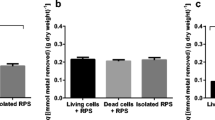Abstract
The effect of the released polysaccharide (RPS) of the cyanobacterium Aphanothece halophytica GR02 on the recovery of the alga by flocculation with ferric chloride was studied. With increasing RPS concentration in algal cultures from 0 to 68 mg L−1 the flocculation efficiency at the same dosage of ferric chloride decreased, and higher dosages of ferric chloride were required to attain the same flocculation efficiency. It is demonstrated that RPS could form complexes with ferrum during flocculation. In conclusion, RPS of A. halophytica GR02 had a significant inhibitory effect on flocculation of the alga with ferric chloride. The inhibitory mechanism of A. halophytica GR02 RPS allows the RPS to compete for ferrum by forming complexes with ferrum, thus leading to the consumption of ferrum in ferric chloride.




Similar content being viewed by others
References
Bernhardt H, Hoyer O, Shell H, Lusse B (1985) Reaction mechanisms involved in the influence of algogenic organic matter on flocculation. Z Wasser-Abwasser-Forch 18:18–30
Bernhardt H, Hoyer O, Lusse B, Shell H (1987) Investigations on the influence of algal-derived organic substances on flocculation and filtration. In: Huck PM, Toft P (eds) Treatment of drinking water of organic contaminants. Pergamon, London, pp 185–216
Borowitzka MA (1988) Algal growth media and sources of algal cultures. In: Borowitzka MA, Borowitzka LJ (eds) Micro-algal biotechnology. Cambridge University Press, Cambridge, pp 456–465
Buelna G, Bhattarai KK, de la Noüe J, Taiganides EP (1990) Evaluation of various flocculants for the recovery of algal biomass growth on pig-waste. Biol Wastes 31:211–222, doi:10.1016/0269-7483(90)90160-T
Cheng WP, Chi FH (2003) Influence of eutrophication on the coagulation efficiency in reservoir water. Chemosphere 53:773–778, doi:10.1016/S0045-6535(03)00510-1
D’Souza FL, Knuckey RM, Hohmann S, Pendrey RC (2002) Flocculated microalgae concentrates as diets for larvae of the tiger prawn Penaeus monodon Fabricius. Aquacult Nutr 8:113–120, doi:10.1046/j.1365-2095.2002.00198.x
Dubois M, Gilles KA, Hamilton JK, Rebers PA, Smith F (1956) Colorimetric method of determination of sugars and related substances. Anal Chem 28:350–356, doi:10.1021/ac60111a017
Gregor JE, Fenton E, Brokenshire G, Brink PVD, O’Sullivan B (1996) Interactions of calcium and aluminium ions with alginate. Water Res 30:1319–1324, doi:10.1016/0043-1354(95)00194-8
Grima EM, Belarbi E-H, Fernández A, Medina AR, Chisti Y (2003) Recovery of microalgal biomass and metabolites: process options and economics. Biotechnol Adv 20:291–315, doi:10.1016/S0734-9750(02)00050-2
Gudin C, Therpenier C (1986) Bioconversion of solar energy into organic chemicals by microalgae. Adv Biotechnol Proc 6:73–110
Hilditch CM, Smith AJ, Balding P, Rogers L (1991) C-phycocyanin from the cyanobacterium Aphanothece halophytica. Phytochemistry 30:3515–3517, doi:10.1016/0031-9422(91)80057-8
Knuckey RM, Brown MR, Robert R, Frampton DMF (2006) Production of microalgal concentrates by flocculation and their assessment as aquaculture feeds. Aquacult Eng 35:300–313, doi:10.1016/j.aquaeng.2006.04.001
Li PF, Liu ZL, Xu R (2001) Chemical characterisation of the released polysaccharide from the cyanobacterium Aphanothece halophytica GR02. J Appl Phycol 13:71–77, doi:10.1023/A:1008109501066
Li WS, Men X, Li PF, Chen L, Liu ZL (in press) Extraction, purification and characterization of phycocyanin from Aphanothece halophytica. J Salt Chem Ind (in Chinese with English abstract)
Morineau-Thomas O, Jaouen P, Legentilhomme P (2002) The role of exopolysaccharides infouling phenomenon during ultrafiltration of microalgae (Chlorella sp. and Porphyridium purpureum): advantage of a swirling decaying flow. Bioprocess Biosyst Eng 25:35–42, doi:10.1007/s00449-001-0278-1
Morris GA, Li P, Puaud M, Liu Z, Mitchell JR, Harding SE (2001) Hydrodynamic characterisation of the exopolysaccharide from the halophilic cyanobacterium Aphanothece halophytica GR02: a comparison with xanthan. Carbohydr Polym 44:261–268, doi:10.1016/S0144-8617(00)00217-4
Takaara T, Sano D, Konno H, Omura T (2007) Cellular proteins of Microcystis aeruginosa inhibiting coagulation with polyaluminum chloride. Water Res 41:1653–1658, doi:10.1016/j.watres.2007.01.035
Yopp JH, Tindall DR, Miller DM, Schmid WE (1978) Isolation, purification and evidence for a halophilic nature of the blue-green alga Aphanthece halophytica Frémy (Chroococcales). Phycologia 17:172–178
Acknowledgements
This study was sponsored by the National Natural Science Foundation of China (No. 30670400) and the Scientific Research Foundation for the Returned Overseas Chinese Scholars, State Education Ministry.
Author information
Authors and Affiliations
Corresponding author
Rights and permissions
About this article
Cite this article
Chen, L., Li, P., Liu, Z. et al. The released polysaccharide of the cyanobacterium Aphanothece halophytica inhibits flocculation of the alga with ferric chloride. J Appl Phycol 21, 327–331 (2009). https://doi.org/10.1007/s10811-008-9371-z
Received:
Revised:
Accepted:
Published:
Issue Date:
DOI: https://doi.org/10.1007/s10811-008-9371-z




